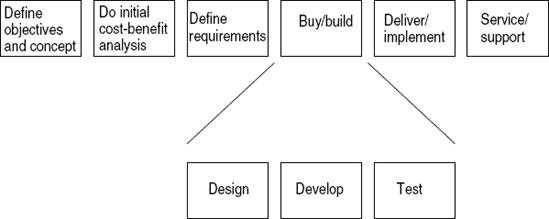2.1. The process breakdown for traditional IT activities
At the most basic level, an internal 'client' (e.g. the marketing department) turns to its internal service provider or 'vendor', the IT department, to solve a business problem by delivering a solution based on information technology. The quotes around the terms 'client' and 'vendor' are deliberate, because it is not a true legal and contractual client-vendor relationship.
The traditional user-IT activities would result in the following high-level processes from start to finish (see Figure 2.1):
Define Objectives and Concept: The client defines the business objectives she expects to meet (e.g. reduce order rejection rate by x%), and the concept which will allow her to achieve this (e.g. a product configurator).
Do initial cost–benefit analysis: The client, with input from IT, then carries out a cost–benefit analysis whose outcome will decide approval and funding. However, because IT in most companies is centrally funded and costs do not come out of the client's budget (or chargeback mechanisms are usually ineffective in regulating demand) this phase is generally present in a subjective form that tends to magnify the benefits and reduce the costs, with the main objective being to get a green light to launch the project.
Figure 2.1. High-level processes for traditional IT activities

Define Requirements: The client and IT jointly ...
Get IT Success!: Towards a New Model for Information Technology now with the O’Reilly learning platform.
O’Reilly members experience books, live events, courses curated by job role, and more from O’Reilly and nearly 200 top publishers.

